Best road bikes 2025: top reviewed bikes from our testing
We choose the best road bikes we've ridden, from budget models to grand tour-proven race machines
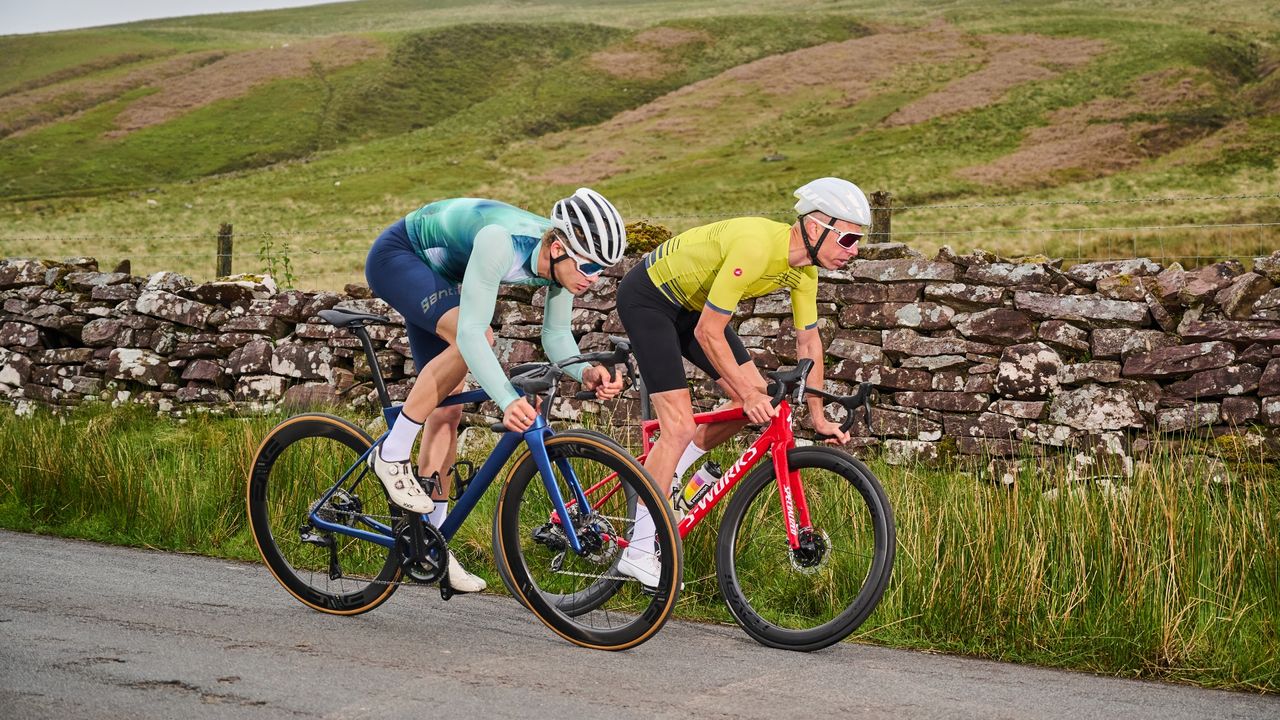

Luke Friend
The road category is expansive, making narrowing down your choices and finding the best road bike for you somewhat tricky. Even if you’re working to a budget, there will still be a vast number of bikes within a price bracket. But help is at hand.
The Cycling Weekly team have ridden and reviewed hundreds of road bikes, including WorldTour machines, those designed for road cycling newcomers, and many in between. This has allowed us to gain valuable insights into which bikes deliver the best ride quality and value for money, as well as those that excel in certain areas, from climbing to endurance. From our testing, we’ve selected a few of our favourites in several categories to help you find the best road bike for you.
As well as choosing specific models that we’ve rated highly, we’ve also provided a guide discussing the many choices you need to consider before buying a bike, from looking at the different frame material options to discussing the influence tube shapes, geometry and tyre width can have on the bike’s overall ride quality
Depending on your budget, we’d also suggest checking our guides to best budget bikes and our Race Bike of the Year (RBOTY) 2025 awards. Likewise if you're after more of an all-road machine, you can read our guide to the best gravel bikes.
Quick list
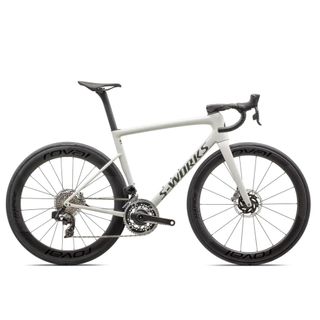
The S-Works Tarmac SL8 is the complete race bike, blending aerodynamics, stiffness and comfort in a super light weight package that excels across differing terrain.
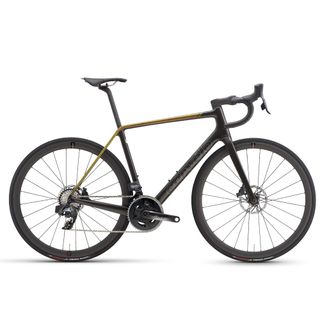
Like every great climbing bike, the Cervélo R5 descends just as confidently as it climbs, while making light work of long rides thanks to the inbuilt compliance.
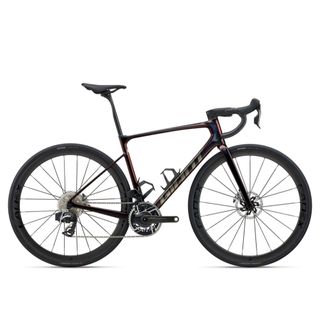
The latest Defy Advanced is lighter and faster than previous models but vitally retains the comfort, sensible geometry and good looks that have made it an endurance bike icon.
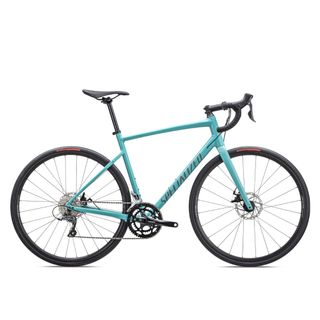
The updated Allez is a well-rounded machine, with disc brakes, plenty of tyre clearance and mounts for fenders while still being decently fast when required.
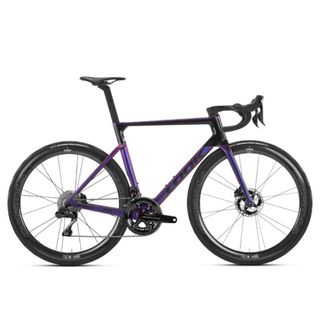
The 795 Blade RS is fast of course, but it's also supremely responsive and surprisingly comfortable, making it not just a great bike for flat roads but for rolling terrain as well.
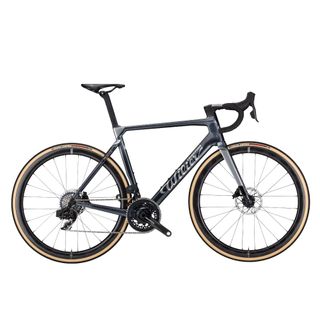
While the Filante isn't a women-specific model its offered in small sizes with vast fit options. As for its attributes it's light, agile and comfortable, making it a superb all-rounder.
Best road bikes we’ve tested at Cycling Weekly
Best Road Race bikes
Good for: all-round performance, one bike garage for climbing, aerodynamic performance, and mixing it up in the bunch. Great for riders who can get into an aggressive position.
The term road race bikes is pretty self-explanatory. These bikes are designed to be fast and offer riders the best all-round performance. Thats not to say they are only for race use, though. For those who like to just ride fast, test themselves and prefer a bike with more direct and agile handling.
Why not check out our full guide to the best road race bikes
Best race bike
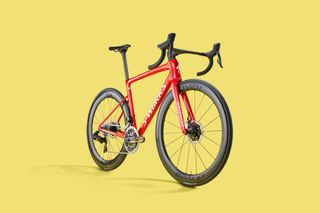
Specifications
Reasons to buy
Reasons to avoid
We awarded the Tarmac SL8 with our Race Bike of the Year award in essence because of its ability to do most things exceptionally well. It makes it such a well-rounded offering and it’s little surprise that it’s excelled at the WorldTour level over such different parcours.
Frame-wise the SL8 makes a few changes from the SL7. There’s the more rounded tube designs and the ‘speed sniffer’ head tube. The former are inspired by Spesh’s featherlight wonder bike, the Aethos and it helps make the SL8 lighter - a claimed frame weight of just 685g - and yet proportionally stiffer than the older model. However, fans of the SL7 will be pleased that in terms of geometry the SL8 is happy to follow suit.
So how does it all impact the ride quality? We’ve ridden the bike for over a year and it remains as good as it did on our first test ride. The slim seat post adds compliance and in turn comfort, as is the rear end of the bike. Given that you can fit 35mm wide tyres here, the SL8 can make genuine claims to being a racing thoroughbred that you could also ride year-round if you so wished.
Indeed, much of the bike’s appeal is that it can handle such a variety of terrain, while still having that top-end speed and acceleration that’s a must for a true racing machine. We’ve ridden at a high level in Europe and we can safely say that few, if any bikes, perform as well across all the categories.
Read more: Specialized S-Works Tarmac SL8 full review
Best value race bike
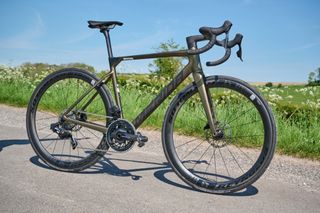
Specifications
Reasons to buy
Reasons to avoid
Good value race bikes aren’t commonplace and the Scultura is far from a budget offering. But for bikes that’s ridden on the WorldTour it does offer plenty for its price tag.
The frameset uses Merida’s top-of-the-line CF5 carbon layup; it uses a percentage of high modulus fibers to deliver an impressive stiffness-to-weight ratio. As a genuine do-it-all race bike it eschews deep aero tubes for something far rounder, designed to reduce weight while adding compliance. There’s also fully integrated cabling and a one-piece carbon cockpit with a claimed weight of just 280g. As for the geometry, it’s as aggressive as Merida’s Reacto aero bike, which will be a bonus if you’re looking for a long and low position on the bike.
Out on the road, its stiffness is apparent at all times, delivering a rock solid bottom bracket and a planted head tube, which makes for quick acceleration and confidence-inspiring descents. The rigid rear end makes it agile and responsive, allowing us to corner with speed and precision. Naturally, this doesn’t translate to all-day comfort, but that’s not what this bike is designed for.
The CF5 frameset is offered in different build options, with the 9000 equipped with Shimano Dura-Ace Di2, and our test bike, the 8000 using Sram Rival AXS. Either way you get a sub 7.5kg race bike for a truly competitive price. And if that’s still outside your budget, we can also highly recommend the 6000, which uses the CF carbon layup and shifts gear via the ever-reliable 105 Di2 groupset.
Read more: Merida Scultura 9000 full review
Best lightweight road bikes
Good for: when the roads head up. Tackling long and steep climbs wherever gram can make a difference. For those who care not about aerodynamics or riding on the flat.
What categorises lightweight bikes is their sole pursuit of offering the lightest weights, with suitable geometry and stiffness for climbing hills effectively. With road race bikes taking a much more all-around approach to performance than they used to and their weights falling drastically, we have seen a decline in the focus on lightweight bikes. However, there are still some cracking bikes out there, and many will be attracted to their rounder, less aero profiles.
Why not check out our full guide to the best lightweight road bikes
Best lightweight bike
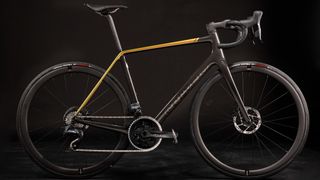
Specifications
Reasons to buy
Reasons to avoid
As a Tour de France winning bike, you expect the R5 to be good. And it is.
The latest version successfully ironed out some of the creases from the previous models. It’s now less stiff, particularly at the front end, which in turn makes it more comfortable over longer distances. We also found that this plushness was perceptible across the entire bike, aided by the flexible D-shaped seat post.
As a climbing bike it’s suitably lightweight - a claimed 703g for a size medium frame - and flies up the hills when required. But importantly it descends well too. During our testing we felt a real connectedness to the road in general, but going downhill this was especially apparent, striking just the right balance at speed so it never felt too soft and thus unsafe or too hard and thus skittery. We felt the fork geometry helped here, ensuring that we could descend with confidence.
Being a race bike, Cervélo has injected the R5 with some aero enhancements. But rather than do this through deep tube shapes that would likely compromise the bike’s comfort it has instead added an integrated cockpit and added a fairing behind the fork crown that smooths airflow onto the down tube.
All told, it adds up to an exceptional bike both for the mountains and otherwise. While it’s not as stiff as a designated aero bike, it delivers greater comfort and in turn versatility, while still being flat-out fast when called upon.
Read more: Cervélo S5 full review
Best value climbing bike
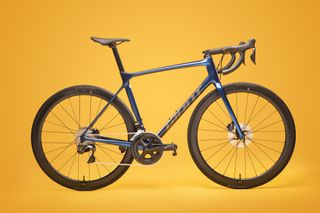
Specifications
Reasons to buy
The TCR is Giant’s lightweight all-rounder. It’s offered across a range of builds and price points (we've ridden and highly rated the top-tier SL 0 model too) but we feel its the Advanced Pro that really does offer great value for money.
The current model differs a little from our review bike and now features fully integrated cabling and a new cockpit; the former is aided by the OverDrive Aero steerer tube technology, with the Contact SL AeroLight stem and Contact SL handlebar finishing the job off. Vitally you still get the Giant Power Pro power meter that impressed us so much, and helps the bike to secure its ‘value for money’ standing.
The ride quality is superbly nuanced. There’s just the right amount of stiffness but given this is a lightweight climber it’s balanced to deliver a lively, springy feel. We found it inspired confidence whether we were going up hill or coming down; again Giant have struck the right balance here between comfort and connectedness.
Components vary depending on the model, but the current TCR Advanced Pro 0 gives you a full Ultegra Di2 12-speed groupset, with the aforementioned power meter, as well carbon Giant SLR 40mm wheels. At this price point it makes it as competitive as they come.
Read more: Giant TCR Advanced Pro full review
Best aero road bikes
Good for: when the speed starts to ramp up or the wind comes into play. For those riding fast and looking to save watts over their competition or buddies.
Aerodynamics plays a significant role in modern cycling, but one must have a foundation to see the benefits. For most, saving a few watts here and there will suffice, while for many, their sleek profiles will be enough of an attraction. It's when speeds increase and the wind begins to factor in that aerodynamic bikes can make a substantial difference.
Why not check out our full guide to the best aero road bikes
Best aero bike
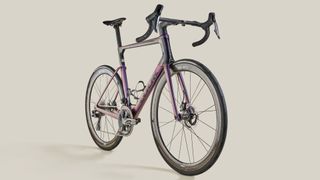
Specifications
Reasons to buy
Reasons to avoid
There’s lots to like about Look’s aero bike, the 795 Blade RS.
It’s WorldTour approved, ridden by the Cofidis team, and stunning to look at. The frameset isn’t the lightest, but the weight has been used wisely, adding stiffness where you want it but without sacrificing compliance; it features 25% Ultra High Modulus carbon in specific areas of the frame to achieve this balance. We certainly noticed the stiffer bottom bracket during our testing, providing us with a snappy ride feel that we’d expect from a bike of this ilk.
The tube shapes are somewhat slender compared to others in this category, and we feel this adds to the bike’s versatility. Yes it’s fast on flat and rolling roads, accelerating quickly and with ease without a hint of movement in the BB area. But it also climbs surprisingly well (our review model weighed 7.48kg for a full Dura-Ace Di2 build) and delivers a relatively comfortable ride for what is an out-and-out race bike. Combined it left us impressed enough to designate the 795 Blade RS the title of ‘best aero bike in our most recent Race Bike of the Year awards.
Read more: Look 795 Blade RS full review
Best value aero bike
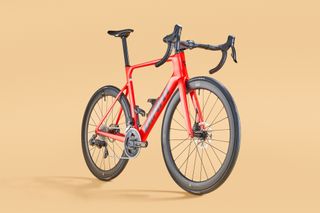
The Giant Propel offers a lot of bike for its price
Specifications
Reasons to buy
Reasons to avoid
The Propel has been around for some time, and has long been one of the best aero bikes on the market striking both a competitive level of performance and price.
The current offering is available as always in an array of models and builds, but it’s the Advanced Pro that we’re focusing on here. The current frame design is less aggressive than previous iterations as Giant sought to add weight and comfort to the aerodynamic considerations. That said, even with the noticeably slimmer tube shapes Giant says this Propel is over 6 watts faster at 40kph than the previous model.
At this level you get a frameset made from Giant’s Advanced Grade Composite, which is the second-tier offering. The brand’s OverDrive system means fully integrated cables via a D-shaped steerer and a new bar and stem design. The result is improved aerodynamics and a far cleaner look in general. As for its geometry, it’s classic 73° parallel angles meaning the Propel isn’t solely an aero bike for special occasions but rather one that can also be an everyday bike for every situation.
During our testing we appreciated how it balanced speed and stability. The slimmer tube shapes made it less susceptible to crosswinds, while the wider tyres and rims combined with improved vibration damping from the front end to create a smooth ride.
At 8.46kg, equipped with Sram’s Rival AXS groupset, it’s by no means a light bike, but the aero enhancements mean that on all terrain other than the steepest slopes, the Propel excels. In fact, we’d be happy to use it as our ‘one and only’ road bike.
Read more: Giant Propel Advanced Pro full review
Best endurance road bikes
Good for: covering big miles in comfort by offering more relaxed positions. They can also potentially tackle tougher terrain, like the cobbles of Paris Roubaix.
Don't be fooled by the words comfort or relaxed; the best endurance road bikes can still pack a turn of speed, especially when the roads or terrain is less than favourable. What distinguishes most endurance road bikes is their more upright position, which is better suited to the flexibility levels of most cyclists. In recent years, the tyre clearances of these bikes have dramatically increased, offering a reasonable amount of crossover with the best gravel bikes, leaning people to brand them as All-road bikes more regularly.
Why not check out our full guide to the best endurance road bikes
Best endurance bike
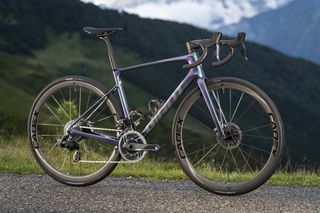
Specifications
Reasons to buy
Reasons to avoid
The Defy has been a stalwart of the endurance category for years, and the latest version suggests that it will remain there.
As with all Giant road bikes there is an extensive range on offer, from the entry-level Advanced models to the range-topping Advanced SL 0, which we’ll cover here.
The frameset has been overhauled and now uses a carbon layup that’s designed to reduce weight while increasing strength. Giant says the SL has seen an almost 30% increase in the stiffness-to-weight ratio, with the frame weight reduced by 200 grams. But being a bike designed for long days in the saddle, there’s a focus on comfort, too. Tyre clearance is up, now with room for tyres as wide as 38mm. There’s also the D-shaped stem and bars, designed to flex and in doing so add comfort. The SLR D-Fuse also benefits from redesigned tops and a gravel bike-style 8º flare on the drops.
On the road it all blends together to create a bike that eats up poor road surfaces, making light work of surfaces that we’d usually find a struggle. The relaxed geometry and longer wheelbase help too, making the Defy a steady ship even when the going gets rough. Giant suggests it’s ideally suited to sportives and gran fondos, and we’d concur. It’s also a great match for any cyclist who racks up the miles of varied terrain, and values luxury and comfort over all-out speed. Think Bentley rather than Ferrari.
Read more: Giant Defy Advanced Pro SL full review
Best endurance bike with suspension
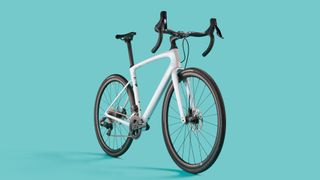
Specifications
Reasons to buy
Reasons to avoid
The latest Roubaix sees a number of changes from previous models. For an endurance bikes, the most significant of these are the wider tyre clearance, up from 33mm to 40mm, the subsequent longer wheelbase and the updated Future Shock suspension - the Expert model is fitted with the Future Shock 3.2, which has no on-the-fly adjustment but is hydraulically damped and can be readily made firmer using different springs and preload washers.
All three were notable during our testing. On rough roads and indeed off-road, the Roubaix had the ability to take the sting out of the toughest sections or tarmac, path or trail, with the front end suspension seemingly doing the lion’s share of the work. The wide tyres certainly help too, and adding a wider contact patch. We particularly enjoyed descending on the Roubaix where the three elements combined to provide us with additional confidence. The Future Shock does have its drawbacks however. On steeper climbs, out of the saddle we found that the notable bounce impacted our efficiency.
Read more: Specialized Roubax SL8 full review
Best budget road bikes
Good for: those just getting into the sport of cycling or those already a road cyclist and looking to add a second bike to their fleet for indoor training or winter use.
Cost-effective bikes, or 'cheap' road bikes, are not solely for beginners. Although they primarily provide price points for those entering the market, they can also offer many benefits to experienced cyclists. Budget bikes tend to be made from metals rather than carbon fibre, yet they can still be excellent performance. Some even favour high-end aluminium offerings—ideal for winter miles or as an affordable path to a high-spec bike.
Why not check out our full guide to the best budget road bikes
Best budget road bike
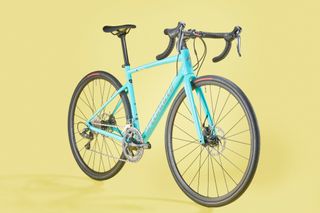
The Specialized Allez now has disc brakes and extra tire clearance
Specifications
Reasons to buy
Reasons to avoid
Specialized's 2023 update of the Allez has added disc brakes in place of the rim brakes on the older model. That has allowed it to increase tire clearance to a more substantial 35mm or 32mm with mudguards. That in turn has provided an extra dose of comfort to the ride and means that the new Allez can handle light gravel duties and isn't confined to smoother tarmac.
We enjoyed this new found versatility when testing - and it even has rack mounts should you fancy throwing in some touring or commuting as well. Vitally though the Allez has still manage to retain its sporty profile, and with a slammed stem in place, we found it to be fast and playful companion.
The base model bike has Shimano Claris 8-speed shifting and mechanical disc brakes. Claris has big jumps between gear ratios on the 11-32t cassette, while we found that , as expected, the mechanical disc brakes just don't have the stopping power of hydraulics.
The Allez line-up now consists of just two models (plus the Allez Sprint). The higher spec Allez Sport has ten speeds and hydraulic disc brakes, but there's a big jump in price for what's otherwise the same spec as the base model.
A wheelset upgrade would significantly improve performance, but all in all it's a decent package for the price, making the Allez reasonably competitive against the other best cheap road bikes we've reviewed.
Read more: Specialized Allez first ride review
Best budget race bike
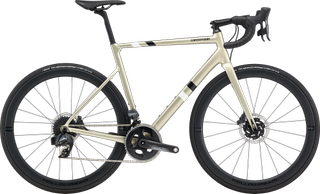
Specifications
Reasons to buy
Reasons to avoid
Cannondale has long been a master of performance alloy frames and the CAAD13 follows in that vein. It's fairly long and low geometry is based on that of the pro-level carbon SuperSix EVO - in fact it shares the same stack height and reach numbers, with a 54 size equating to a stack height of 55.5cm and a reach of 38.4cm.
The aero tube profiles are also borrowed from the WorldTour bike and we found that the combination resulted in superb handling as well as a smooth ride - one that we felt closely resembled that of a carbon frameset. Granted we tested a high-spec model with decent wheels and tires that certainly didn't hinder the experience as some entry level components somehow can.
However, at the lower price points the CAAD13 is affordable enough to be a first bike but with a frame that you won't outgrow - and one that we believe warrants any significant upgrades you make, whether it be wheels or groupset.
That said, even if you opt for a 'cheaper' model you can get a Shimano 105 hydraulic groupset with a RS510 crank set, while the wheels match DT Swiss R470 rims with the Formula hubs - all perfectly good kit. Below this in the pecking order is a Tiagra equipped offering, while rim brake fans will pleased to know that you can get the CAAD13 with calipers!
As per usual, the size range starts at 44 and goes all the way up to 62, with six sizes inbetween. We see this as another big plus point for the CAAD13, making it available not only to a range of budgets thanks to the build options but also wide range of rider builds.
The only thing that we found fault with was the rather high front end stack. It's easy to rectify but means you'll have to have your head tube cut down to avoid an ugly stack of spacers above the stem.
Read more: Cannondale CAAD13 Disc full review
Best Women's road bikes
Good for: female riders and those of smaller builds.
While you certainly don't have to ride a women's specific bike, there can be a number of benefits, especially if you are a smaller or shorter rider. Women's bikes tend to offer sizing down to XXS and certainly offer more feminine colour options. When it comes to fit, form and specification, there is little to no difference between 'men' or standard road bikes. In reality, a lot of women's specific models are there to help brands differentiate their marketing. Don't let that deter you from considering one, as brands like Liv, which feature prominently in our guide to the best women's road bikes, provide some truly outstanding options, sometimes even better than the standard versions.
Why not check out our full guide to the best women's road bikes
Best lightweight women's bike
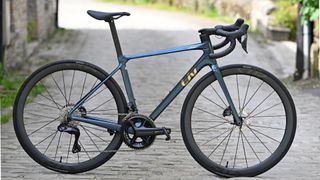
Specifications
Reasons to buy
Reasons to avoid
The latest Liv Langma is a pure race bike. It's monocoque carbon frame is both light and stiff, with new airfoil sections and fully integrated cables to reduce drag and ultimately the bike faster.
And it works. During testing we couldn't fault the Langma on the flat, delivering plenty of stiffness that translated to quick accelerations and plenty of urgency. But what makes this bike great is its ability to shine across the board. We took it up and down steep climbs as well on long, all-day rides and it excelled at both. It's surprisingly stable for a bike that's so light and agile, and there's little compromise when it comes to comfort too, given it's racing pedigree.
As for the components, the Pro 0 comes equipped with both the redesigned Liv Contact SLR bars and a Cadex Max 40 wheelset alongside the reliable Shimano Ultegra Di2 groupset, that delivered ab impeccable shifting and braking experience throughout the review period.
Read more: Liv Langma Advanced Pro 0 full review
Best women's bike

Specifications
Reasons to buy
Reasons to avoid
The Filante SLR is here in the women's section because rather than be a women-specific model it is instead a road bike that's offered in both a full range of sizes, down to XS, as well as benefitting from Wilier's Accufit system that enables smaller riders to dial in their fit; the carbon cockpit comes with five stem length options and there are also spacers that allow the bike's stack to be increased by as much as 35mm. Add in a couple of seat post variants and you have a bike that can be easily customised.
To achieve a light but stiff bike, the carbon frame's construction uses liquid-crystal polymer that translates to plenty of strength without the weight. There's also a super-wide fork that's designed to aid airflow and thus reduce drag.
During our testing we came to love the blend of speed and stiffness but also the comfort too. It's the latter attribute that had us believing that the Italian brand had successfully redefined just what an aero bike can be.
Read more: Wilier Filante SLR full review
How we test the best road bikes
We have a dedicated team of testers here at Cycling Weekly, whose job is to review a whole range of cycling products and to write objective reviews of their experience of using them day in day out in a whole range of conditions.
With huge experience, they're really well placed to compare products, identify their strengths and weaknesses and bring you an honest, unbiased assessment of how they perform.
When it comes to testing road bikes we log hundreds of miles, looking at a number of factors as we assess their overall performance. Of course we consider what the bike is primarily designed for, whether it's an aero race bike, a lightweight climber or an endurance model but also look at more general considerations such as build and spec quality, durability and value for money.
How to choose the best road bike for you
What's the difference between race and endurance geometry?
A key decision when choosing the best road bike for you is what you plan to do with it. Are you looking to go fast or race, or are you after a more comfortable bike for leisurely rides or long days in the saddle?
Geometry is the key factor here. A full-on race bike will put you in a more bent-over riding position, with your head and shoulders lower down over the handlebar. That’s great when you have a need for speed, reducing your frontal profile to lower your wind resistance but can be uncomfortable, particularly for a beginner.
On the other hand, bikes labelled 'endurance' or 'sportive' will be designed for a more upright riding position, with the bars higher and closer to the saddle. That delivers greater comfort on longer rides, but may make you a bit slower.
If you’re riding on hilly roads, or planning a trip abroad to the Alps for example, you’ll certainly appreciate a lightweight bike. However, if you're going to spend your time riding fast on flatter terrain then aerodynamics are probably more important to you. And If you’re looking to race, the stiffer, more edgy handling of a race bike will work better than the more stable handling of an endurance machine.
An increasing number of bikes are designed to take you off the tarmac as well as letting you ride efficiently on road. A gravel bike will give you wide tires and lower gears. But many endurance or 'all-road' bikes now offer plenty of tire clearance as well as an expansive gear range, letting you take in a wider variety of routes.
How much do I need to spend on a road bike?
You also need to look at how much you want to spend on a bike. That’s not just the initial outlay, but the cost of replacing worn or damaged parts, the cost of servicing your bike and the cost of any upgrades. There’s a big difference in price between lower spec mechanical parts and top of the range electronic gearing.
A bike's specs will vary a lot between manufacturers. In particular, prices will often be lower at direct only brands (such as Canyon and Ribble) and in-house brands (Vitus at Wiggle or Boardman at Halfords). But to give you an idea, here's a look at common specifications at various investment levels. In the interest of brevity, some bandings are wide and therefore you would expect variation within them.
£750 - £999 / $1000 - $1500
An aluminium frame and carbon fork, aluminium seatpost and handlebar/stem, shifting at Shimano Sora or Claris level, aluminium wheels. Rim brakes.
£1000 - £2000 / $1500 - $2500
Either an aluminium frame and carbon fork at around Shimano 105 level, or a carbon frame and fork with shifting at Shimano Tiagra level. Aluminium wheels, seatpost and handlebar/stem. Disc or rim brakes.
£2000 - £3500 / $2500 - $4000
Carbon frame and fork with Shimano 105 (lower end of budget) or Ultegra (higher end), aluminium or carbon rims, carbon seatpost, aluminium handlebars and stem. Disc brakes should be hydraulic from this price point. Titanium frames are an option.
£3500 - £5000/ $4000 - $6000
Carbon or titanium frame and fork, Shimano Ultegra or SRAM AXS eTap groupset, carbon seatpost, aluminium bar/stem, carbon rims
£5000 - £10,000 / $6,000 - $12,000
Carbon frame and fork, Shimano Dura-Ace Di2 or SRAM Red AXS eTap, carbon wheels of 50mm+, carbon bars and stem.
£10,000+ / $12,000+
Accept nothing but the best of everything. Top of the range carbon frame and fork - usually utilising stiffer carbon and therefore fewer layers resulting in lower weight, carbon wheels of 50mm+, one piece carbon bar/stem Shimano Dura-Ace, SRAM Red AXS or Campagnolo Super Record Wireless, power meter as standard.
What are the best frame materials for road bikes?
A major difference between cheaper and more expensive bikes is their frame material. Bikes costing under $/£1000 are typically made of aluminium alloy, with the tubes welded together. It’s a material used in more expensive bikes too and can result in a strong, lightweight machine.
But pricier bikes are usually made of carbon fibre. The fibres give the bike strength and are embedded in a synthetic resin to hold them together. The mix of fibres used and their lay-up determine the bike’s ride feel. More expensive bikes will use more high modulus carbon fibre, which lowers the weight without reducing the bike’s strength.
Titanium is another material used in some more expensive bikes. It’s lightweight, strong and doesn’t rust or fatigue. And you can still find bikes made of steel tubing, which was the traditional framebuilding material. It’s not quite as light as other choices, but robust and gives a distinctive ride feel.
You should also look at what the bike’s fork is made of. Many bikes will have an all-carbon fork or one with carbon fork blades and an alloy steerer. This tends to absorb road bumps well for a more comfortable ride, but you can find alloy or steel forks on some lower priced bikes.
How do I choose the right size road bike for me?
It’s important to get the right size bike. Most bikes come in a range of sizes to fit your stature and bike makers will usually publish a rider’s height range which a bike of a specific size will fit.
You should feel comfortable seated on your bike and be able to put both feet flat on the ground when standing over the crossbar, without it touching you.
You’ll usually find more detailed frame dimensions listed too, which give you more details of how your bike will fit you. The most important are reach and stack, although they’re a bit complex to interpret.
In general, the higher the stack number (usually shown in cm or mm) the more upright your riding position will be. If you enjoy a 'taller' riding position then look for a more generous stack height. Equally, a shorter reach will put you closer to the bars, thus in a more upright position. For the most part, race bikes will feature a lower stack height than endurance models.
To make sure that your bike is set up correctly and to avoid the risk of injury from incorrect fit, it’s well worth getting a professional bike fit. A bike fit will cost some money, although sometimes a bike shop will offer one at a discount or free when you buy a bike. A bike fit will ensure that your saddle and bars are optimally placed for efficient riding. Consider a good fit an investment.
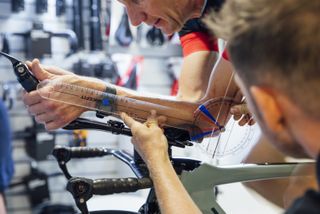
A bike fit should help you get more comfortable
What is an 'aero' road bike and do I need one?
Bike makers push their bikes’ aero credentials, especially on more expensive machines, with claims of wind tunnel testing and time saved. Time was, an aero frameset was significantly heavier than one with the traditional round tubes, but the best aero bikes can now be as light as a non-aero one.
On the other hand, around 80% of the wind resistance comes from the rider, not the bike and those time savings are typically when riding at around 45kph/28mph. Since wind resistance increases as the cube of speed, if you’re riding at half that, you’ll have an eighth of the drag, so all those aero features won’t make a lot of difference.
How many gears should a road bike have?
After the frame, gears are the most important thing to consider when choosing a road bike. Today many top end road bikes will come fitted with 12-speed cassettes. When paired with a double chainring this means you'll have 24 gears. Remember however that some of these gear ratios will be duplicated in certain chainring/cassette combinations.
More affordable road bikes tend to come with fewer gears. These cassette options should range from 8-speed to 10-speed, again most often paired with a double chainset.
As for groupset brands, Shimano gearing is the most common, but the other major options are SRAM and Campagnolo. Shimano’s top end groupsets, Dura-Ace, Ultegra and 105 have a 12-speed cassette, while less expensive bikes may come with 10-speed Tiagra, 9-speed Sora or 8-speed Claris.
SRAM and Campagnolo also offer 12 speeds on their top end road bike groupsets and all three brands offer electronic shifting rather than the mechanical cables used on lower priced ranges.
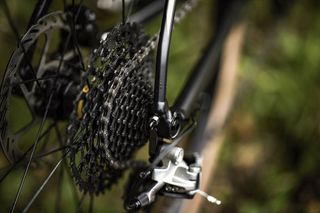
Wider range cassettes help in the hills
What are the best gear options for a road bike?
When choosing a new road bike it's important that you think about the gears it comes equipped with. Fortunately if you've already matched your potential bike to the kind of riding you plan on doing, there's a good chance that the gear choice will also be well-suited.
An out-and-out race bike may come with a more traditional gearing set-up, for example 53/39 tooth chainset paired with an 11-30 tooth cassette.
However road bikes that fall into the endurance or sportive categories are likely to have a compact chainset, most likely a 50/34, and a cassette that will have 30, 32, 34 or even 36 teeth as the largest option. The lower gears will help you to both tackle steep hills with more ease and generally pedal with a higher cadence. However, this can mean larger gaps between gear ratios.
There are other options out there too. SRAM, for example, now offers its eTap AXS groupsets with 48/35, 46/33 and 43/30t chainsets. Paired with its cassettes starting at 10 teeth, these give similar highest gear ratios to traditional gearing starting at 11 teeth, but greater low-end gear range for easier climbing and less need to shift between chainrings on undulating roads.
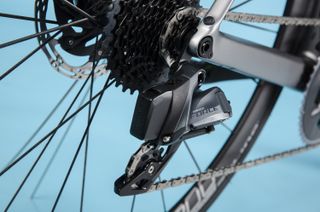
Electronic shifting is now a mainstream option on higher spec bikes
Is electronic shifting really better?
While the major groupset brands - Shimano, SRAM and Campagnolo - still offer mechanical groupsets, there has been a significant shift towards electronic shifting in recent years. Here a motor shifts the derailleurs between ratios, rather than the traditional cable.
The main electronic systems are Shimano Di2, Campagnolo Wireless and SRAM eTap AXS, which all offer 12 speeds.
There are benefits and drawbacks of both mechanical and electronic options.
Mechanical components, such as mechs and levers, are generally cheaper and lighter than their electronic counterparts. They are also, for the most part, easier to fix when something goes wrong.
Electronic gears benefit from reliable shifting. There's no cable tension at play here. If you've suffered a hand injury, the ease of changing gear with the press of a button could be appealing.
Electronic gearing can be personalised through an app, allowing you, for example, to shift multiple gears seamlessly. However, all this tech doesn't come cheap and complete road bikes fitted with electronic gears will be more expensive. Plus, you've got to remember to charge the batteries.
Are rim or disc brakes best for a road bike?
Disc brakes have largely taken over on road bikes and all but the lowest priced bikes are now in general disc brake only. That said, you can still find rim brake bikes, usually at either end of the price spectrum.
Typically disc brakes give you more consistent braking, whatever the weather conditions, better modulation and greater overall stopping power. On the flip side, they’re heavier than rim brakes, although bike makers have been able to make frames lighter, largely mitigating the extra weight.
Most disc brake bikes use hydraulic calipers, although you can find mechanical disc brakes, usually on cheaper machines. Discs have been creeping down the price range for the last few years, which means it's still likely an option even if your budget is limited.
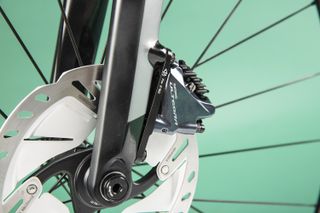
Disc brakes are a feature of the majority of new road bikes
What is the difference between carbon and alloy wheels?
Road bike wheels are typically 700c size, although the smaller 650b size can be found on some smaller frames. Regardless of size, both are available as carbon or alloy options.
Carbon fibre rims are used on most of the best road bike wheelsets. These rims lower weight and are often deeper, to improve aerodynamics over a shallow wheel. In fact carbon can be produced in a far greater range of shapes, allowing manufacturers to create wheels optimised for a varied range of riding styles.
Alloy rims are generally cheaper and will feature on many complete road bikes. They are usually heavier than their carbon counterparts although lightweight alloy options are available.
Wheels are a component where bike makers often look to economise, so a budget wheelset may feature even on an expensive bike. It’s worth considering whether you’ll need to upgrade them to get the best out of your new bike. If you decide to do so, you can always keep the original set for winter riding.
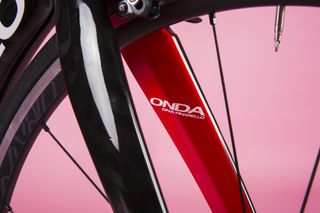
Wider tyres let you reduce tyre pressure, increasing comfort and grip
What is the best tire width for a road bike?
There was a time when tire options for road bikes were limited by the frames they were fitted to. A 23mm tire was commonplace. If you were lucky you might be able to squeeze a 25mm into your frame.
However, today road bikes now come with increasingly wide tires due largely to the advent of disc brakes; even race bikes will typically have clearance for 28mm to 32mm tires, while endurance machines will likely allow for wider still. It's worth noting that even if your new bike has come specced with 25mm or 28mm tires, there's a good chance it will have the clearance for something wider.
With wider tires it's possible to run a lower tire pressure for more comfort and added grip. Wider tires can be as fast as or faster than narrower widths as well.
Wheels and tires are increasingly tubeless-ready too. This means that you can add sealant and dispense with the inner tubes, reducing the risk of punctures and upping grip and ride comfort even more. Tubeless tires are in general faster as well.
Get The Leadout Newsletter
The latest race content, interviews, features, reviews and expert buying guides, direct to your inbox!
Paul started writing for Cycling Weekly in 2015, covering cycling tech, new bikes and product testing. Since then, he’s reviewed hundreds of bikes and thousands of other pieces of cycling equipment for the magazine and the Cycling Weekly website.
He’s been cycling for a lot longer than that though and his travels by bike have taken him all around Europe and to California. He’s been riding gravel since before gravel bikes existed too, riding a cyclocross bike through the Chilterns and along the South Downs.
- Luke FriendFreelance writer
-
 Is creatine a useful supplement for cyclists?
Is creatine a useful supplement for cyclists?One the few supplements with a strong evidence base, creatine promises explosive gains, finds Rob Kemp
By Rob Kemp Published
-
 Inside the world of social media and pro cycling - the good, the bad, and the viral
Inside the world of social media and pro cycling - the good, the bad, and the viralCandid, quirky and sometimes snarky, social media connects riders with fans like never before
By Katy Madgwick Published
